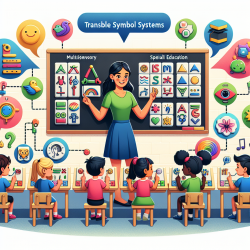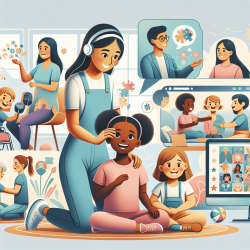As professionals in the field of special education and speech therapy, we continuously seek innovative methods to improve communication skills in individuals with multisensory impairments. One such method that has shown promising results is the use of Tangible Symbol Systems. This approach is particularly beneficial for individuals who face challenges with traditional communication methods due to severe communication deficits.
Tangible Symbol Systems are designed to bridge the gap between presymbolic communication (such as natural gestures) and abstract symbolic communication (like formal language). They provide a physical, tactile means of communication that is more accessible to individuals with multisensory impairments. These systems can be tailored to the unique needs of each individual, making communication more meaningful and effective.
The implementation of Tangible Symbol Systems requires a thoughtful approach, starting with the selection of appropriate symbols that are meaningful and recognizable to the user. These symbols can range from objects or parts of objects to textured tags or shapes. The key is to ensure that each symbol has a clear, consistent meaning and is used in a way that is relevant to the individual's daily life and communication needs.
One of the strengths of Tangible Symbol Systems is their versatility. They can be used across all ages and for individuals with various disabilities, including autism, severe mental retardation, developmental disabilities, and orthopedic impairments. This adaptability makes them a valuable tool in the special education and speech therapy fields.
To effectively implement Tangible Symbol Systems, educators and therapists must embed symbol use into functional routines. This involves creating opportunities for communication within naturally occurring situations, allowing individuals to practice and apply their communication skills in real-life contexts. For example, a symbol could be used to signify a favorite activity, such as a swing or a book, which the individual can then request using the tangible symbol. This practical application of symbols enhances learning and reinforces the connection between the symbol and its referent.
Tracking progress is an essential component of working with Tangible Symbol Systems. By using pretests and data forms, educators and therapists can monitor the individual's understanding and use of the symbols. This information is crucial for adjusting the approach and ensuring that the communication system remains effective and relevant to the individual's needs.
While Tangible Symbol Systems offer a powerful means of enhancing communication for individuals with multisensory impairments, it's important to remember that success requires collaboration. Families, educators, and therapists must work together to support the individual's communication development. This collaborative effort ensures that the tangible symbols are integrated into all aspects of the individual's life, providing a consistent and supportive environment for learning and growth.
In conclusion, Tangible Symbol Systems represent a significant advancement in the field of communication for individuals with multisensory impairments. By providing a physical, tactile means of communication, these systems open up new avenues for expression and interaction. As special education professionals and speech therapists, it is our responsibility to explore and implement these systems, always with the goal of enhancing the communication skills and quality of life for those we serve.
For those interested in delving deeper into the methodology and benefits of Tangible Symbol Systems, I highly recommend exploring the research and resources available. A great starting point is the research article titled "Tangible Symbol Systems: Symbolic Communication for Individuals with Multisensory Impairments." This comprehensive guide offers valuable insights and practical strategies for implementing tangible symbol systems effectively. To read the original research paper, please follow this link.










